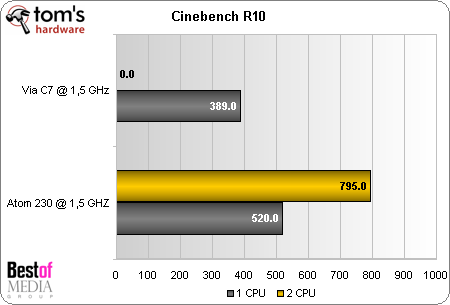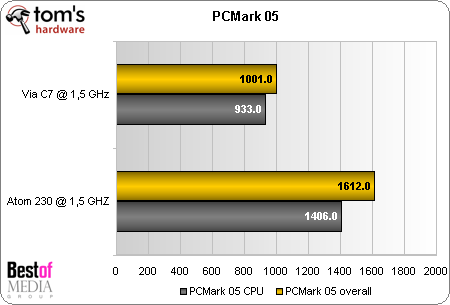Intel Atom CPU Review
Atom against C7-M and Celeron
We also decided to compare our Atom platform with two other systems that could find themselves in competition with our test Mini-ITX motherboard. The first is the Via PC3500G mobo; the second is an entry-level processor sometimes used in ultraportables, the Celeron-M (Dothan).
Compared to the C7
The Via PC3500G motherboard is a micro-ATX board with a CN896 chipset coupled with a C7 CPU clocked at 1.5 GHz. For the test, we dropped the clock of the Atom to the same frequency as the C7’s (12 x 125 MHz, or 1.5 GHz). The memory, hard disk, and operating system stayed the same.

On Cinebench R10, as you can see, the Atom was faster than the C7, but not by much – at least when using a single thread. On the other hand, the Atom’s HyperThreading resulted in an impressive performance gain.

On PCMark 05, you can see that the Atom platform, even at an identical frequency, was faster than the C7 platform. There are several reasons why. PCMark 05 is multithreaded, like many current programs, and the Atom’s HyperThreading has an advantage. Also, the Intel chipset is significantly faster (or a little less slow, let’s say) than Via’s.
Finally, we measured the power consumption of the two platforms. Surprise: Thanks to a power-saving chipset, the Via platform was more economical than the Intel platform. At idle, the PC3500G drew 49 W, whereas the GA-GC230D was at 59 W. But notice that under load, the Atom only climbed by 3 W, whereas the Via platform consumed 10 W more (while still staying below the Intel). Note that these values are measured at the AC outlet, without taking power-supply losses into account (ours has approximately an 80% yield).
Compared to the Celeron-M
For the comparison with the Celeron-M, we used a portable PC equipped with a model based on the Dothan core. We didn’t run the PCMark tests because, since the machines are very different, the tests wouldn’t have been valid. As for the C7, the Atom was underclocked to the same frequency as the Celeron-M (in this case 1.3 GHz).

On a synthetic test like Cinebench R10, you can see that the Celeron showed approximately twice the performance at an identical frequency. Still, HyperThreading let the Atom gain a few points.
Get Tom's Hardware's best news and in-depth reviews, straight to your inbox.
In practical terms, these few tests show that the Atom ranks between the C7 and the Celeron-M at an identical frequency. Given that the two processors are being used in Netbooks (the C7 with frequencies close to the Atom’s and the Celeron-M with significantly lower frequencies), we can conclude that Atom-based computers will have performance that’s more or less identical to that of current machines.
Current page: Atom against C7-M and Celeron
Prev Page Atom Against Pentium E and Sempron Next Page Overclocking and 3D-
joefriday Celerons have significantly lower frequencies than Atom? umm...no. Only the ULV celeron M has a lower freqency. Modern notebooks start with Celerons at least 1.6GHz, more likely 1.86GHz, and are built on the much more modern Merom architecture, which have at least a 10% IPC advantage over the old Dothan architecture. No, atom is nowhere NEAR a modern Celeron in performance. Nice try though.Reply -
joefriday Also, Why not have a Celeron 420 by now? Are you telling me that THG, with all its money, can't budget in a $30 CPU for comparative testing?Reply -
joefriday After reviewing the article, I can say I'm thoroughly unimpressed with the Atom platform (at least the current desktop derivative). If anyone can remember, THG did a $300 PC build using now ancient Celeron Ds and AMD Semprons. One thing that I find amazing, is that those old rigs both use LESS power than this Atom desktop rig.Reply
http://www.tomshardware.com/reviews/the-300-pc,1546-10.html
-
randomizer Don't you people understand that Atom is not a desktop processor? You can't compare its performance to a desktop processor fairly because that's not what it is designed for.Reply -
joefriday This Atom CPU is on a desktop board. That means it's fair game, especially when the processors being compared are also comparable in price.Reply -
randomizer It's on a desktop board, woopdedoo. If you could get your mobile phone processor to run on a desktop board would you compare it to an E2160?Reply -
joefriday Who cares what the Atom CPU is SUPPOSED to be. It is right now, in this review, on a desktop-oriented package, built to compete with low power consumption desktop computers. It fails miserably in that regard, as it is neither low power consumption, nor competitive. In your ridiculous example, if I had a mobile phone processor on a desktop board, and it ended up consuming more power than an E2160/motherboard combo that costs the same amount of money, all the while performing much worse than the e2160, I would call the mobile phone cpu on a desktop motherboard either A FAILURE or AMD. Take your pick.Reply -
apaige So, for the Intel Atom, you do use an updated version of Sandra, but not for the Phenom. You compare it to the VIA C7, a 3 year-old CPU, but not the VIA Nano, which will be available in the same timeframe as the Atom. You don't provide graphics for power consumption, despite the Atom being designed for low power consumption; surprise, the old C7-M system draws less power.Reply
Biased much? -
Not sure that Nano's are really available yet, still a newer mini-itx based C7 (say EPIA-M700) would have been better, since you would be looking at even less power than the one used and the VX800 will end up used with the Nano. The D201DLY would have been good to compare to, would also give some idea how the Atom would go paired with SiS chipsets.Reply